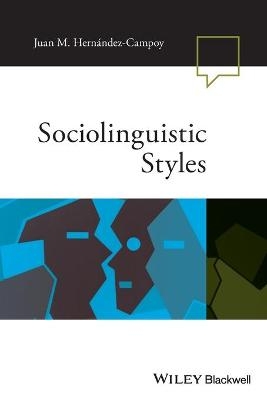
Sociolinguistic Styles
Wiley-Blackwell (Verlag)
978-1-119-55543-8 (ISBN)
Full examination of the complex phenomenon of style-shifting in sociolinguistics, focusing on its nature and social motivations, as well as on the mechanisms for its usage and its effects
In-depth, up-to-date critical overview of the different theoretical approaches accounting for stylistic variation, exploring their historical roots not only in sociolinguistics and stylistics or semiotics but also in classical fields such as rhetoric and oratory
Coverage of a wide range of related concepts and issues, from the oldest Greek ethos and pathos or Roman elocutio and pronuntiatio to the contemporary enregisterment, stylisation, stance, or crossing
Written by an academic who has been instrumental in developing theory in this area of sociolinguistics
Juan M. Hernández-Campoy is Professor in Sociolinguistics at the University of Murcia, Spain. His books include Style-Shifting in Public (with J.A. Cutillas-Espinosa, 2012), Diccionario de Sociolingüística (with P. Trudgill, 2007), Metodología de la Investigación Sociolingüística (with M. Almeida, 2005), and??Geolingüística (1999). He is the co-editor with J.C. Conde-Silvestre of The Handbook of Historical Sociolinguistics (Wiley-Blackwell, 2012).
List of Figures x
List of Tables xiv
Series Editor’s Preface xvi
Acknowledgements xvii
Introduction xviii
Part I The Concept and Nature of Style 1
1 The Concept of Style 3
1.1. Style in Rhetoric 3
1.1.1. Ancient Greece 4
1.1.2. The Roman world 7
1.1.3. The Middle Ages and modern times 10
1.2. Style in Stylistics and Semiotics 17
1.2.1. Textualists 19
1.2.2. Contextualists 24
1.2.3. Recent Developments 28
1.3. Style in Sociolinguistics 29
Notes 31
2 The Nature of Style 33
2.1. The Linguistic Meaning of Style: Resources and Mechanisms 33
2.1.1. Style, Register and Diaphasic Variation 33
2.1.2. Style, Dialect and Accent 36
2.1.3. Style and Genre 39
2.1.4. Style, Register, Slang, Cant and Jargon 41
2.1.5. Stylistic Devices 43
2.1.6. Style and the Study of Language Change 49
2.2. The Social Meaning of Style: Motivations 51
2.2.1. Style and Identity 54
2.2.2. Style and Ideology 57
Notes 61
Part II Sociolinguistic Models of Style‐Shifting 63
3 Situation‐centered Approach: Attention Paid to Speech 65
3.1. Social Determinism and Positivism 65
3.1.1. Sociolinguistic Tenets 65
3.1.2. Sociolinguistic Patterns 69
3.2. The Formality Continuum 77
3.2.1. Casual Style 78
3.2.2. Formal Style 78
3.2.3. Passage Reading Style 78
3.2.4. Word List Style 79
3.2.5. Minimal Pairs Style 80
3.2.6. The Style Decision Tree 80
3.3. Audio‐monitoring: The Universal Factor 82
3.3.1. The Principle of Graded Style‐shifting 83
3.3.2. The Principle of Range of Variability 84
3.3.3. The Principle of Socio‐stylistic Differentiation 85
3.3.4. The Principle of Sociolinguistic Stratification 87
3.3.5. The Principle of Stylistic Variation 90
3.3.6. The Principle of Attention 90
3.3.7. The Vernacular Principle 90
3.3.8. The Principle of Formality 91
3.4. Limitations 91
Notes 93
4 Audience‐centered Approach: Audience Design 95
4.1. Behaviorism and Social Psychological Theories 95
4.1.1. Language Attitudes 97
4.1.2. Social Identity Theory and the Linguistic Marketplace 99
4.1.3. Communication Accommodation Theory 101
4.2. Bakhtin and Dialogism 105
4.2.1. Centripetal and Centrifugal Language Forces 105
4.2.2. Heteroglossia and Multiple Voicing 107
4.2.3. Addressivity and Response 108
4.3. The Style Axiom: Audienceship and Responsiveness 109
4.3.1. Relational Activity 116
4.3.2. Sociolinguistic Marker 116
4.3.3. Responsiveness and Audienceship 118
4.3.4. Linguistic Repertoire 119
4.3.5. Style Axiom 120
4.3.6. Accommodative Competence 122
4.3.7. Discoursal Function 123
4.3.8. Initiative Axis 124
4.3.9. Referee Design 125
4.3.10. Field and Object of Study 126
4.4. Limitations 128
Notes 129
5 Context‐centered Approach: Functional Model 131
5.1. The Context of Situation and Contextualism 131
5.2. Systemic Functional Model of Language 133
5.3. Polylectal Grammar 134
5.4. The Register Axiom 138
5.5. Limitations 143
Notes 144
6 Speaker‐centered Approach: Speaker Design 146
6.1. Social Constructionism 146
6.1.1. Phenomenology 147
6.1.2. Relativism 148
6.2. Social Constructionist Sociolinguistics: Persona Management 148
6.2.1. Indexicality, Social Meaning and Enregisterment 150
6.2.2. Agency 157
6.2.3. Performativity, Stylization, and Identity Construction 158
6.2.4. Stance 173
6.2.5. Authenticity 175
6.2.6. Hyperdialectism vs. Hypervernacularization 179
6.2.7. Crossing 181
6.3. Limitations 182
Notes 182
7 Conclusion 185
Note 191
References 192
Index 221
| Erscheinungsdatum | 17.12.2019 |
|---|---|
| Reihe/Serie | Language in Society |
| Verlagsort | Hoboken |
| Sprache | englisch |
| Maße | 150 x 224 mm |
| Gewicht | 363 g |
| Themenwelt | Geisteswissenschaften ► Sprach- / Literaturwissenschaft ► Sprachwissenschaft |
| ISBN-10 | 1-119-55543-4 / 1119555434 |
| ISBN-13 | 978-1-119-55543-8 / 9781119555438 |
| Zustand | Neuware |
| Haben Sie eine Frage zum Produkt? |
aus dem Bereich


